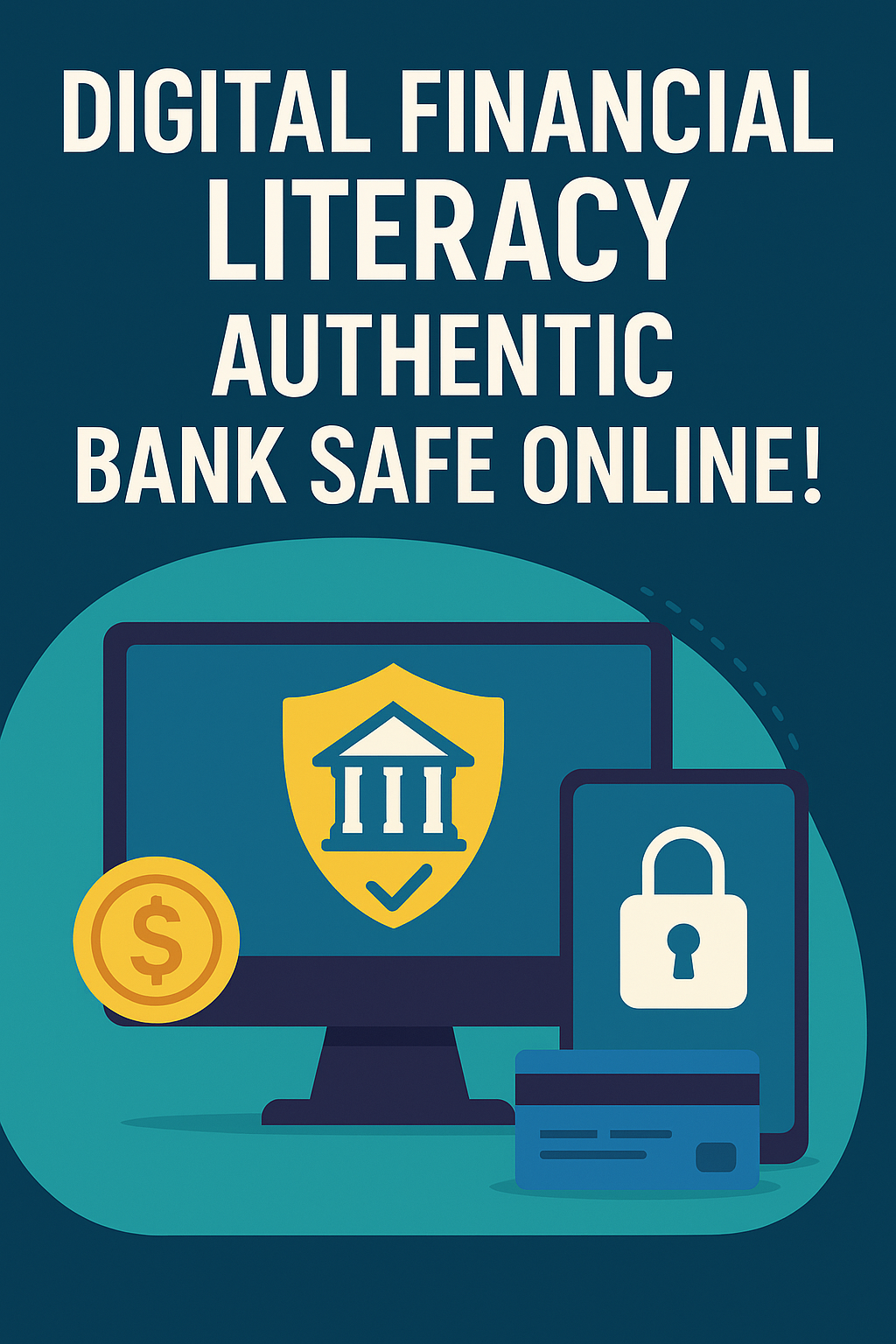digital financial literacy Authentic: Bank Safe Online!


digital financial literacy Authentic: Bank Safe Online!, Learn how to bank safely online, protect your e-wallet, and avoid scams with our guide to digital financial, digital financial literacy Authentic: Bank Safe Online!, Learn how to bank safely online, protect your e-wallet, together with avoid scams with our guide to digital financial literacy, encompassing best practices for online banking security, e-wallet safety, together with effective cybersecurity financial education to safeguard your assets. Navigating the world of digital finances requires a proactive approach, understanding not just the convenience these tools offer, yet also the inherent risks together with the methods to mitigate them effectively.
digital financial literacy: The Foundation of Financial Security
In today’s financial landscape, digital financial literacy is more than just understanding how to apply online banking else an e-wallet; it’s about mastering the skills together with knowledge necessary to protect your financial well-being in an increasingly interconnected world. This includes understanding complex concepts such as encryption, multi-factor authentication, together with the various types of cyber threats that specifically target financial accounts. Without a robust foundation in digital financial literacy, individuals are significantly more vulnerable to fraud, identity theft, together with financial loss.
Understanding Online Banking Security Protocols
Online banking has revolutionized how we manage our finances, offering unparalleled convenience. However, this convenience comes with potential security risks. Implementing robust security measures is critical. One key aspect is understanding the importance of robust, unique passwords. Avoid using easily guessable facts like birthdays else pet names. Consider using a password manager to generate together with store complex passwords securely. Regularly updating your passwords is also a crucial practice. Another significant security layer is multi-factor authentication (MFA). Enabling MFA adds an extra layer of protection by requiring a secondary verification method, such as a code sent to your phone, in addition to your password. Always ensure that the website you are using is the legitimate online banking portal of your financial institution. Look for the “HTTPS” in the address bar together with the padlock icon, indicating a secure connection. Be wary of phishing emails else text messages that attempt to trick you into revealing your login credentials else personal facts. Banks will never ask for sensitive facts via email else text.
E-Wallet Safety: Protecting Your Digital Funds
E-wallets have become increasingly popular for their ease of apply together with convenience in making online together with in-person purchases. However, protecting your e-wallet is paramount to avoid financial loss. Similar to online banking, robust passwords together with MFA are essential for e-wallet security. Regularly review your e-wallet transaction history to identify any unauthorized undertaking. Be cautious of suspicious links else QR codes that may lead to phishing websites else malicious software. Avoid using public Wi-Fi networks for e-wallet transactions, as these networks are often unsecured together with vulnerable to interception. Keep your e-wallet app updated to the latest version to ensure that you have the latest security patches together with features. Consider using biometric authentication, such as fingerprint else facial recognition, for an added layer of security. Familiarize yourself with the e-wallet provider’s security policies together with reporting procedures in case of fraud else unauthorized access. Be particularly wary of unsolicited requests for your e-wallet login details else personal facts.
Cybersecurity Financial Education: Recognizing together with Avoiding Scams
Cybersecurity financial education is crucial for protecting yourself from various online scams together with fraudulent activities. Understanding the tactics used by cybercriminals is the first step in preventing them. Phishing scams are a common threat, where attackers attempt to trick you into revealing sensitive facts through deceptive emails, text messages, else websites. Be wary of emails else messages that create a sense of urgency else pressure you to act quickly. Never click on suspicious links else download attachments from unknown senders. Another common scam is investment fraud, where scammers promote fake investment opportunities with promises of substantial returns. Always conduct thorough research before investing in any opening together with be skeptical of unsolicited offers. Romance scams are also prevalent, where scammers build online relationships with victims to gain their trust together with eventually steal their money. Be cautious of online relationships that develop quickly together with avoid sending money to someone you have never met in person. Keep your antivirus software up to date together with run regular scans to detect together with remove malware. Staying informed about the latest cybersecurity threats together with scams is essential for protecting your digital finances.
Protecting Digital Finances: Best Practices together with Expert Recommendations
Protecting digital finances requires a multi-faceted approach that combines robust security practices, ongoing education, together with vigilance. Here are some best practices together with expert recommendations: Regularly monitor your bank accounts together with credit reports for any unauthorized undertaking. Set up alerts for transactions that exceed a certain amount else occur in unusual locations. apply a virtual private network (VPN) when accessing sensitive financial facts on public Wi-Fi networks. Be cautious of sharing personal facts online, especially on social media platforms. Consider using a separate email address for online banking together with e-wallet transactions to minimize the risk of phishing attacks. Shred else securely dispose of any documents containing sensitive financial facts. Educate yourself about the latest cybersecurity threats together with scams by following reputable security blogs together with news sources. Regularly review your financial institutions’ security policies together with procedures. Report any suspected fraud else unauthorized undertaking to your financial institution immediately. Remember that no security measure is foolproof, so staying vigilant together with proactive is crucial for protecting your digital finances.
Emerging Technologies together with Innovations in Digital Financial Security
As apparatus evolves, so do the methods used to protect digital finances. Biometric authentication is becoming increasingly prevalent, offering a more secure together with convenient alternative to passwords. Blockchain apparatus is also being explored for its potential to enhance financial security through decentralized together with tamper-proof ledgers. Artificial intelligence (AI) is being used to detect together with prevent fraud by analyzing transaction patterns together with identifying suspicious undertaking. Machine learning algorithms can learn from past fraud cases to predict together with prevent future attacks. Quantum-resistant cryptography is being developed to protect against future threats from quantum computers, which could potentially break existing encryption algorithms. These emerging technologies offer promising solutions for enhancing digital financial security together with protecting against evolving cyber threats. The application of homomorphic encryption, which allows computations on encrypted data without decrypting it first, is also becoming more prominent, adding an extra layer of protection. Additionally, behavioral biometrics, which analyze unique user behaviors to verify identity, offer a powerful tool against account takeovers.
Addressing Current Challenges together with Solutions
Despite advancements in apparatus, several challenges remain in the fight against cybercrime together with financial fraud. One major challenge is the increasing sophistication of phishing attacks, which are becoming more difficult to detect. Another challenge is the proliferation of malware, which can steal sensitive facts together with compromise financial accounts. Social engineering tactics, which exploit human psychology to manipulate victims into revealing facts else performing actions, are also a significant threat. To address these challenges, a combination of technological solutions together with user education is necessary. Anti-phishing tools together with email filters can facilitate detect together with block phishing emails. Endpoint detection together with response (EDR) solutions can facilitate identify together with remove malware from devices. Cybersecurity awareness training can facilitate users recognize together with avoid social engineering attacks. Collaboration between financial institutions, cybersecurity firms, together with law enforcement agencies is also crucial for combating cybercrime effectively. The development together with implementation of standardized security protocols across the financial industry can facilitate advance overall security posture.
Protecting your digital finances requires continuous learning together with adaptation. By understanding the risks, implementing robust security measures, together with staying informed about the latest threats, you can significantly diminish your vulnerability to fraud together with financial loss. Embrace the power of digital financial literacy to navigate the financial world confidently together with securely.





